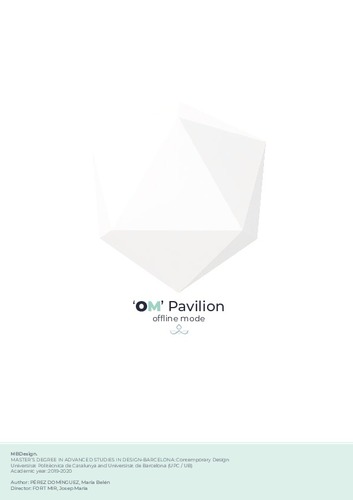Mostra el registre d'ítem simple
"OM Pavilion", offline mode
| dc.contributor | Fort Mir, Josep Maria |
| dc.contributor.author | Pérez Domínguez, María Belén |
| dc.date.accessioned | 2020-11-30T14:33:22Z |
| dc.date.available | 2020-11-30T14:33:22Z |
| dc.date.issued | 2020-10-22 |
| dc.identifier.uri | http://hdl.handle.net/2117/333532 |
| dc.description.abstract | Qué tal si pausamos todo por un instante y nos preguntamos ¿qué tanto nos afecta nuestro contexto? Sin darnos cuenta estamos sumergidos en este estrés social cotidiano, nuestra mente está expuesta a problemas económicos, sentimentales, medioambientales y de salud, sumando a esto lo que causa vivir en una ciudad caótica llena de ruido, contaminación visual, gente caminando todo el día sin parar. Pero qué tal si llevamos uno de estos problemas a una solución inmediata, un espacio en el medio de la ciudad que te transporte mediante ciertas herramientas de diseño, de punto A a punto B mediante percepciones y sensaciones. Así nace el pabellón OM, un espacio creado para la gente de la ciudad de Barcelona, con el principal objetivo de hacer que la mente pueda descansar y desconectar sin tener que ir a la montaña, a un museo, un curso de yoga o a una parte desolada lejos o remota de la ciudad. OM está implantada en medio de la urbe, y tiene la facilidad de poder ser trasladada a cualquier lugar público, desde un parque, una rambla o a un festival, cumpliendo siempre el mismo objetivo, lograr crear atmósferas de experimentación que lleve a la mente a otro estado, una cápsula de tiempo que mientras afuera todo circula: autos, gente, sonidos, redes sociales y la desorganización de una ciudad latente, adentro es un espacio que traslada a la gente a un mundo sensorial y de percepciones. Gracias a los materiales utilizados es un pabellón ligero, sostenible y adaptable a cualquier contexto que despierta los sentidos. Es un espacio que crea un impacto positivo a la salud mental e invita a que toda la gente pueda usarlo de manera práctica, gracias a la tecnología utilizada ya que involucra una aplicación para manejarla y tomando en cuenta las circunstancias en la que nos encontramos, ya que es un pabellón individual que respeta el distanciamiento social. |
| dc.description.abstract | How about pausing for a moment and asking ourselves how much our context affects us? Without realising it, we are immersed in this daily social stress, our minds are exposed to economic, sentimental, environmental and health problems, adding to this what it causes to live in a chaotic city full of noise, visual pollution, people walking all day without stopping. But what if we take one of these problems to an immediate solution, a space in the middle of the city that transports the people by applying certain design tools, from point A to point B by means of perceptions and sensations. This is how the OM pavilion was born, a space created for the people of the city of Barcelona, with the main aim of allowing the mind to rest and disconnect without having to go to the mountains, a museum, a yoga course or a desolate part of the city. OM is implanted in the middle of the city, and it has the facility to be moved to any public place, from a park, a boulevard or a festival, always fulfilling the same objective, to manage to create atmospheres of experimentation that take the mind to another state, a time capsule that while outside everything circulates: cars, people, sounds, social media and the disorganization of a latent city, inside it is a space that moves people to a world of senses and perceptions. Thanks to the materials used, it is a light, sustainable and adaptable pavilion for any context that awakens the senses. It is a space that creates a positive impact on mental health and invites all people to use it in a practical way, thanks to the technology used as it involves an application to manage it and taking into account the circumstances in which we find ourselves, as it is an individual pavilion that respects social distance. |
| dc.language.iso | eng |
| dc.publisher | Universitat Politècnica de Catalunya |
| dc.subject | Àrees temàtiques de la UPC::Arquitectura::Disseny |
| dc.subject | Àrees temàtiques de la UPC::Arquitectura::Tipologies d'edificis |
| dc.subject.lcsh | Buildings, Temporary -- Design and construction |
| dc.subject.lcsh | Temporary structures (Building) -- Design and construction |
| dc.subject.lcsh | Mobile apps |
| dc.subject.lcsh | Meditation--Therapeutic use |
| dc.subject.lcsh | Architecture -- Psychological aspects |
| dc.subject.other | Multisensorial |
| dc.subject.other | Transportable |
| dc.subject.other | Materialidad |
| dc.subject.other | Atmosfera |
| dc.subject.other | Ciudad |
| dc.subject.other | Multisensory |
| dc.subject.other | Transportable |
| dc.subject.other | Materiality |
| dc.subject.other | Atmosphere |
| dc.subject.other | City |
| dc.title | "OM Pavilion", offline mode |
| dc.type | Master thesis |
| dc.subject.lemac | Construccions temporals -- Disseny i construcció |
| dc.subject.lemac | Estructures desmuntables -- Disseny i construcció |
| dc.subject.lemac | Aplicacions mòbils |
| dc.subject.lemac | Meditació -- Ús terapèutic |
| dc.subject.lemac | Arquitectura -- Aspectes psicològics |
| dc.identifier.slug | PRISMA-150116 |
| dc.rights.access | Open Access |
| dc.date.updated | 2020-10-28T19:42:28Z |
| dc.audience.educationlevel | Màster |
| dc.audience.mediator | Escola Tècnica Superior d'Arquitectura de Barcelona |
| dc.audience.mediator | Universitat de Barcelona. Facultat de Belles Arts |
| dc.audience.mediator | Escola Politècnica Superior d'Enginyeria de Vilanova i la Geltrú |
| dc.audience.degree | MÀSTER UNIVERSITARI EN ESTUDIS AVANÇATS EN DISSENY-BARCELONA (Pla 2017) |
| dc.contributor.committeeMember | Moret Viñals, Oriol |
| dc.contributor.committeeMember | Monguet Fierro, José María |
| dc.contributor.committeeMember | Voltas Aguilar, Jordi |
| dc.contributor.committeeMember | Mendoza Ramírez, Héctor |
Fitxers d'aquest items
Aquest ítem apareix a les col·leccions següents
-
Màster universitari en Estudis Avançats en Disseny-Barcelona (MBDesign) [174]
Titulació interuniversitària UPC-UB




